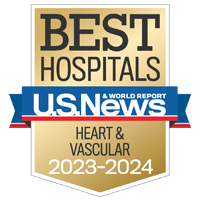Tetralogy of Fallot

Overview
Tetralogy of Fallot is a combination of four heart defects that can result in a baby turning blue or cyanotic because of a lack of oxygen in the blood. It usually is diagnosed in infancy.
The heart consists of four chambers: the two upper chambers, called atria, where blood enters the heart; and the two lower chambers, called ventricles, where blood is pumped out of the heart. Valves that act as one-way doors control the flow between the chambers and between the arteries. The heart also has been pictured as two side-by-side pumps with one side pumping blood into the lungs and the other side pumping blood from the lungs back to the body.
Blood is pumped from the right side of the heart up through the pulmonary valve and the pulmonary artery to the lungs, where the blood is filled with oxygen. From the lungs, the blood travels back down to the left atrium and left ventricle and is then pumped through another big blood vessel called the aorta to the rest of the body.
Our Approach to Tetralogy of Fallot
UCSF provides comprehensive, highly specialized care for adults living with heart defects such as tetralogy of Fallot. Our dedicated team of experts offers a wide array of services, including thorough medical evaluations, advanced treatments, long-term monitoring, and personalized recommendations on diet, exercise, psychosocial support and family planning.
Awards & recognition
-

Among the top hospitals in the nation
-

One of the nation's best in cardiology and heart & vascular surgery
Signs & symptoms
The four defects characteristic of this condition include:
- An abnormal opening in the wall separating the ventricles called a ventricular septal defect (VSD) that allows blood to go directly from the right to left ventricle without going through the lungs.
- A narrowing of pulmonary valve or below the valve called pulmonary stenosis that partially blocks blood flow to the lungs.
- An overly muscular right ventricle, also called right ventricular hypertrophy.
- A displaced aorta, also called overriding aorta or Ao, directly over the abnormal opening between the ventricles.
Babies with tetralogy are blue at birth or soon after, and have detectable heart murmurs, an extra sound in the heartbeat. Activity such as crying may exacerbate the condition and babies may have shortness of breath or may faint. Babies also may experience a "tetralogy spell" in which oxygen levels drop suddenly leading to irritability and then sleepiness or unresponsiveness.
Most adults with tetralogy of Fallot have had surgery during childhood. The adult with unrepaired tetralogy usually has milder cyanosis and a heart murmur or extra heart sound.
Diagnosis
A complete cardiac evaluation for tetralogy of Fallot will include:
- Echocardiography, in which a picture is made of the heart by using sound waves
- Chest X-ray
- Electrocardiogram (EKG or ECG), which records the heart's electrical activity
- Examination of the oxygen content of arterial blood. This is usually done with an oximeter, a little light that can be placed on a finger. Sometimes, a blood sample may be drawn from an artery in the wrist and checked for content of oxygen, carbon dioxide and acidity.
Treatments
The defects usually are corrected during a single operation done when the baby is about 6 months old unless the baby has inadequate oxygen. If the baby is too small, there may be two surgical procedures. The first procedure connects the pulmonary arteries to the aorta or its branches by a tube called a shunt to supply blood to the lungs. Later surgery enlarges the pulmonary valve opening and closes the ventricular septal defect (VSD) with a patch so that blood flows easily into the pulmonary artery and lungs. The shunt is then removed.
Most people with tetralogy have had corrective surgery by the time they reach their teens. If they have only had shunts placed, they probably will need to have a complete repair including shunt removal.
Adult patients with tetralogy of Fallot should be seen by a cardiologist specializing in the care of adults with congenital heart disease to monitor for late complications. All patients will need to take antibiotics during subsequent surgeries or dental procedures to protect against endocarditis. They also need to be monitored regularly for any subsequent complications or heart rhythm disturbances. The most common late complication is a leaky pulmonic valve, called pulmonic regurgitation, that may require subsequent surgery. Nevertheless, most patients will lead relatively normal lives and women with repaired tetralogy of Fallot can have successful pregnancies.
UCSF Health medical specialists have reviewed this information. It is for educational purposes only and is not intended to replace the advice of your doctor or other health care provider. We encourage you to discuss any questions or concerns you may have with your provider.











